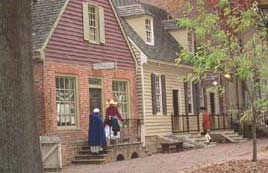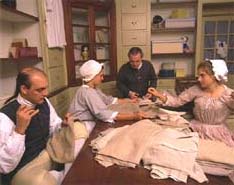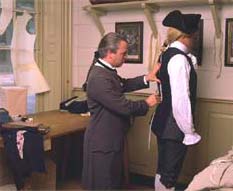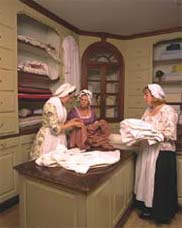Page content
The Millinery Shop
by Edward R. Crews

Restored Shop fronts Duke of Gloucester Street.
Mark Hutter has an impeccable Savile Row style. When he becomes James Slate, a tailor freshly arrived in Williamsburg from London in 1774, he embodies a mix of polish, deference and understated confidence. He knows what an 18th Century gentleman requires in a wardrobe. With equal skill, Hutter can offer advice on hats made from bobcat or beaver, or breeches of deerskin or a winter coat made of the best English wool and crafted to last a lifetime. “Green is a fine color,” says Hutter, pulling a bolt of cloth from a shelf in Colonial Williamsburg's millinery shop for an interested visitor. “A great coat will last a long time. It's considered an investment for a gentleman.”
Janea Whitacre, who portrays 18th Century storeowner Margaret Hunter, presents the same poised and knowledgeable attitude when she welcomes visitors as if they were customers. “What do you buy?” she asks, offering them the traditional Colonial merchant's greeting. Her line is the perfect icebreaker for 20th Century Americans. Products of a powerful advertising-driven consumer society, they welcome the sales come-on, the invitation to spend and enjoy. They also quickly discover at Margaret Hunter's shop – often to their surprise – when it comes to shopping, buying and keeping pace with changing fashion our Colonial ancestors could teach us a thing or two.
Today, we tend to think that in America during the 1700s clothing styles changed little with three-cornered hats, wigs and floor-length gowns serving as fashion mainstays. Popular perception, however, is wrong. Fashion in Colonial Virginia was vibrant, fickle, fleeting, fun and something of an obsession for the middle and upper classes. It also was part of the Trans-Atlantic trade between Great Britain and her American colonies.
“Keep in mind that fashion changed as fast as the weather in England and hence in Virginia, therefore what style or philosophy was in vogue one year would be forgotten the next,” said Whitacre who oversees the interpretation at the millinery shop. “It is comforting to know that 18th Century people were concerned about the rapidly changing fashion and the amount of time, energy and money lavished on fashion as we are in this century.”
This 18th Century love of fashion and the art of making clothes are expressed exuberantly, passionately and pleasantly at Colonial Williamsburg's millinery shop. It is a bright, busy, entertaining place. Through the skill and involvement of the shop's main three tradespeople (augmented at times by other fashion trade interpreters), the clothes of the 1700s come alive, taking on a vibrancy denied them in a static museum display.
This spirit reflects an expanded view of the millinery shop's role at Colonial Williamsburg. For many years, the shop focused its interpretation of fashion on women's hats and shopkeeping. The atmosphere was closer to the classroom and museum than that of a Colonial shop. In recent years, however, interpreters have broadened their approach, tackling topics like the English garment industry in the 1700s, women in business, finance, international commerce, apprenticeships, trade technologies and techniques, economic history and the ebb and flow of 18th Century fashion for men, women and children.

Interpreters Robert Trio (left), portraying a soldier, and Mark Hutter (center), portraying tailor James Slate, join two women from the military encampment to sew haversacks and shirts for the Virginia Army of 1775.
This effort has found a comfortable niche and respect among other Colonial Williamsburg crafts. In 1995, the Colonial Williamsburg Trade Council approved creation of an apprenticeship at the shop. This 6-year program ensures that a candidate spends three year mastering basic 18th Century sewing skills and an additional three more years learning either tailoring or gown making, referred to as mantua making 200 years ago.
The millinery shop also has established itself as a popular stop for thousands of visitors who come to Colonial Williamsburg every year. The shop's acceptance is due mainly to the serious commitment of its three interpreters - Whitacre, Hutter and Doris Warren - to sharing with visitors their knowledge about 18th Century fashion. They do this most of the time by trying to make the shop look and sound like it might have in the 1700s. For example, items in the shop are displayed as if for sale. Paper patterns hang in the front window. Straw hats line the counter. Stays hang on a line above.
And, all three interpreters busy themselves with shop-related activities. Hutter stuffs an infant's mattress with horsehair. Warren, portraying Elizabeth Carlos from the 1700s, sews in a corner, showing visitors the finer points of 18th Century hand stitching. Whitacre greets “customers” at the door, welcoming them to the shop and, usually, the world of 1774.
Like all parts of Colonial Williamsburg, the millinery shop takes special efforts to tie its activities to wider themes. When a recent theme dealt with the Revolutionary War, the shop demonstrated how the fashion trades would support the army. Shop personnel lately have worked with the theme of family, showing how the shop catered to 18th Century parents shopping for a new baby.
Whitacre has had much to do with the shop's success and evolution. She began a lifelong love affair with sewing and Williamsburg as a child. She first worked in Colonial Williamsburg during 1982 as a summer employee. Today, she is supervisor of the fashion trades, overseeing the work of six interpreters involved in textile making, wig making and the millinery shop. During the past 15 years, she has found that clothes and fashion are popular topics with visitors because they are – for the most part – easily understood. However, she also finds that 20th Century Americans are sometimes confused over precisely what a milliner was and what happened in a millinery shop.

Tailor James Slate, portayed by Mark Hutter, takes the measure of a customer, interpreter James Loba, in the market for a vest or perhaps a waistcoat.
“Part of the trouble is that no exact parameters exist for this business,” Whitacre said. “It could range widely. A main function of a millinery shop was to make and sell fashionable accessories for men and women. That meant that a store's product line could range from clothes to wares, like watches, clocks and table service.”
In the 1500s and 1600s, the millinery business involved shopkeepers who dealt in milanese (as in Milan, Italy) ware, like silks, ribbons, armor, swords and other Italian goods. Millinery, however, began to change its meaning as swords and armor fell out of fashion. The word also took on a new life as English retailing underwent a big shift in the mid-1600s.
The Great Fire of London in 1655 had a lot to do with this change. Prior to the fire, trades were concentrated along certain streets. After the fire, trades intermingled in new shopping districts. Shopkeepers also began selling many goods and services in their stores, offering customers greater convenience and expanded choices. A milliner could carry possibly a thousand different goods, becoming the forerunner of the modern department store. At this point, the term “milliner” was tied to the Latin word "mille," meaning thousand.
The 18th Century milliner might have offered a thousand goods but all shared the quality of being fashionable accessories. Wares could include shoes, jewelry, table service, clocks, hosiery, fabrics, shirts, aprons, cloaks, caps, hats, muffs and mitts.
“The goods from the world were in this shop,” Whitacre said. And, from the shop they found a place in the lives of Virginians from every class. A planter's daughter might own a gown of Chinese silk, underclothing made of Dutch linen and shoes from England. A slave might wear a shirt of linen made in Northern Europe, wool hose from Scotland and a knitted cap from England.
By offering many goods, the 18th Century millinery shop attracted a wide range of customers, Whitacre said. A Colonial Williamsburg milliner probably served every class from the plantation owner to his slaves, who needed pins, needles and thread.

Millinery shop owner Margaret Hunter, portrayed by Janea Whitacre (left), examines some of her cloth inventory with interpreters Doris Warren (center) and Krista Haines (right).
The best customers, though, were people with money, according to Whitacre. That meant the upper class and the middle class – planters, tradesmen and shopkeepers. Modern Americans frequently are surprised to learn that these groups had clothes made for them by others.
“An impression we often encounter is that people in this period commonly made their own cloth and clothing,” Whitacre said. “The truth is that very little of this was done at home. There simply wasn't enough time for one family to make its own cloth and clothing.”
In addition, clothing producers knew then -- as they do now -- that one way to keep sales humming was to keep styles changing. The whirl of fashion during the 1700s was endless and often contradictory. Consider these facts. During the 18th Century, ladies' skirt styles changed five times. It was not unheard of for hat styles to change 17 times during a 2-year period.
Another factors that kept fashion in a stir was that no enduring consensus existed during the period as to what constituted stylish clothing. Commentators couldn't even agree on whether or not clothes made the man. It is impossible therefore even for just one year, like 1774, to say anything too absolute about what was appropriate, desired or trendy.
This lack of consensus, however, didn't blunt Virginians fascination with fashion, a fascination that might have been just a bit too keen. You get a sense that maybe Colonial Virginians were trying somewhat too hard to keep up with their English cousins.
“I came across a letter while doing some research that warned an Englishman planning a trip to the colonies that he'd better dress 'up' for success, if he was coming to Virginia,” Whitacre said. “The letter writer said to him that you can get by in London without paying too much attention to your clothes. But, in Virginia, you'd better wear your best to make the right impression.”
Other visitors noticed this tendency toward finery as well. “Solomon in all Glory was not array'd like on of These,” wrote Rev. Jonathan Boucher of upper class Virginians in 1759. “I assure you, Mrs. James, the common Planter's Daughters here go every Day in finer Cloaths than I have seen content you for a Summer's Sunday. You thought (homely Creatures as your are) my Sattin Wastecoat was a fine best, Lord help You, I'm noth'g amongst the Lace and Lac'd fellows that are here. Nay, so much does their Taste run after dress that they tell me I may see in Virginia more brilliant Assemblies than I ever c'd in the North of Engl'd, and except Royal Ones P'rhaps in any Part of it.”
English fashion dominated in Colonial Virginia. In England, however, French styles had a wide following, particularly among the upper classes. This link was so strong that people joked a gown worn in Paris this week easily could reappear at a London soiree the next.
Colonists had an insatiable appetite for news, particularly fashion news, which reached America fairly quickly given the slow transportation of the day. In the early 1770s, Virginians learned about the latest styles through English newspapers and magazines. The news typically was six to eight weeks old when it got here, but it was welcome never-the-less.
Colonial Virginians were not so fashion hungry that it blinded them to reality. They acknowledged that while nice clothes were desirable, garments did not necessarily reveal the true nature of the wearer.
“Clothing was viewed as an outward sign of prosperity, and they did admit that a person might be judged by their clothes in a place where they were not known, but one truly and accurately could not be judged by his or her clothes alone,” Whitacre said. “A lady who was dressed as a poor person and a poor person who dressed as a wealthy one never really became the station that they were appearing to be dressed. A lady would always be a lady no matter how she was dressed; because it was her deportment, manner, civility, fine bearing and speech that would betray her station. Only by looking at the appearance and the manner could one really see who was wearing what.”
If 20th Century visitors are completely comfortable with 18th Century attitudes about fashion, style and consumption, they tend to be utterly surprised at the important role women played in this business. While Colonial women generally focused their attention on domestic matters, women were found in all trades, especially in the millinery business. Women shopowners in this field were common, and society did not offer any extraordinary obstacles to them trying their hand at business.
“Women had a place in commercial life. Those who reached their majority and were not married could own property, buy and sell, sue and be sued, represent themselves in court, make contracts and perform other routine commercial and legal functions,” Whitacre said. “In short, they had all the rights of men. They did not have the privileges of voting or holding public office.”
During the 18th Century, Williamsburg had six millinery shops, all run by women. When Whitacre greets visitors as the shopowner, she assumes the character of one of these women, Margaret Hunter. The facts about her life are few and sketchy. Hunter apparently came to Williamsburg in 1767. That same year, her sister, Jane, leased a building to use as a millinery shop. Margaret worked in the millinery business in England prior to coming to America. Margaret seems to have worked with her sister until 1771 when she advertised her own shop. She apparently was still in business during 1780, the year she ran her last advertisement. We know nothing more about her except that she died in 1787.
Naturally, a millinery store owner also needed to know about fashion and the intricacies of the clothing business. A well-informed entrepreneur might know about sewing, tailoring, gown making, laundrying, ironing and making and maintaining fine lace.
Granted, it was a lot to learn. All this knowledge and all these skills, however, were within the grasp of enterprising 18th Century women. And, Whitacre admits that she takes an honest pleasure in telling the story of these female business pioneers.
Looking ahead, Whitacre hopes to continue telling their story and to continue telling it in greater breadth and depth. She also hopes to broaden Colonial Williamsburg's interpretation of the millinery shop. Her long range plans include: establishing a separate tailor shop, continuing to reproduce items in Colonial Williamsburg's clothing and fashion collection, increasing the shop's special order work and enhancing the interpretation of the business side of the millinery shop.
In the meantime, the tradespeople at the millinery shop will continue to sew, to educate and to keep alive the Colonial entrepreneurial spirit, one best embodied in Whitacre favorite farewell to modern visitors.
“Remember,” she tells them with a smile on her face, “I'm here to tempt your eye and empty your pocketbook.”
This article is reprinted with permission from Colonial Williamsburg, Winter 1997-98, pp. 63-67.
Learn more:
